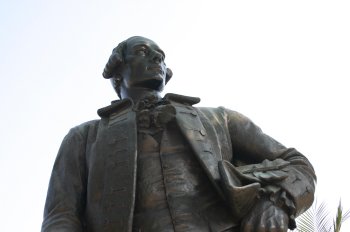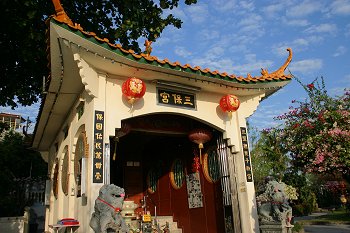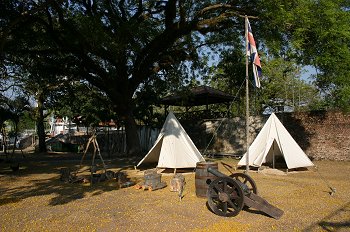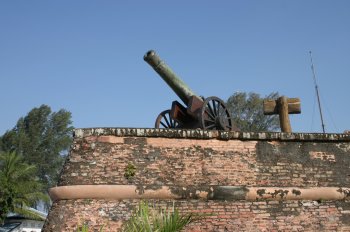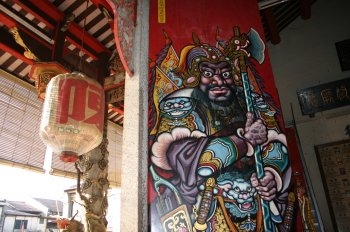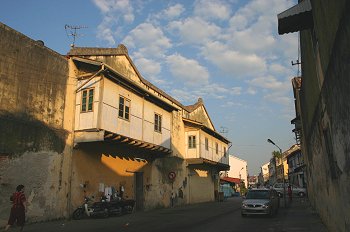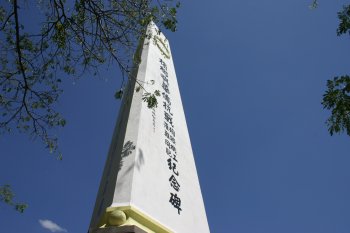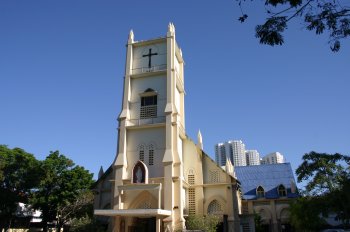

History of Penang
 Go Back - Latest PENANG Sights/Streets/New Properties > Malaysia > World | Hokkien : Lessons : Dictionary | YouTube | Facebook | About Me : Contact Me
Go Back - Latest PENANG Sights/Streets/New Properties > Malaysia > World | Hokkien : Lessons : Dictionary | YouTube | Facebook | About Me : Contact MeThe whole story of Penang is of course much more than that, and in my opinion, very much more interesting. Having dug into many of the historical records for my research, I am keen to tell you the story, and I hope you will find it as enjoyable as I did.
There is substantial evidence to suggest that Penang Island has long been inhabited before Francis Light stepped ashore. Of course, much of its history until then went unrecorded, as it was simply an unimportant island where fishermen and pirates stopped over. It was first mentioned in the chronicles of Admiral Zheng He, the Chinese eunuch who explored the "south seas" in the 15th century. Zheng He's armada is believed to have dropped anchor somewhere in Batu Maung, at the southeast tip of Penang Island. Today a shrine dedicated to Zheng He's gigantic footprint stands on the boulder at Batu Maung, patronized by the locals.
The existence of Penang Island was noted by early French as well as Portuguese navigators, as well as by Sir James Lancaster, the 16th century trader who documented having passed by in 1592. He anchored off Pulau Rimau, and wrote that he buried there a few of his men who succumbed to scurvy. Between then and the late 18th century, Penang Island was nothing more than a humid, mosquito-infested island, its coast lined by mangrove swamps, its hinterland uncleared jungle. Malay fishermen built makeshift fishing huts along the coast while the mangrove forest served as hide-outs for pirates.
Penang's modern history began in 1786 when Captain Francis Light landed there to establish a British trading settlement. At that time, Penang was the property of the Sultan of Kedah. Light had been working as a trader with the British East India Company since 1765. He plied the coast of the Malay peninsula from Junk Ceylon (present-day Phuket, Thailand), down to Kuala Muda in Kedah.
Some history books claimed that the Sultan of Kedah turned to Light to fight off Siamese invasion. While the then Sultan of Kedah, Sultan Muhammed Jiwa Zainal Abidin II (1741-1778) feared invasion from the Siamese as well as the Burmese, his most immediate threat came from the Bugis in Selangor. There had been trouble within the Kedah royal household resulting in the expel of a rebellious faction. This faction brought their grievances to the Bugis in Selangor, instigating them to invade Kedah. In 1771 the Bugis launched an invasion, causing the Sultan to flee north into Perlis.
Unable to mount a counterattack against the Bugis, he sought help from the British East India Company, but received a non-committal response. In distress, he turned to the one person he knew well, a merchant trader who was fluent in Malay and understood local customs: Francis Light.
Sultan Muhammed Jiwa asked Light to help him not only get protection against the Bugis, but rather launch an offensive to wrest his kingdom back. In return, he was prepared to hand over Kuala Kedah Fort to the British. He told Light if the British would not help him, he would turn to the Dutch.
Francis Light immediately wrote to his superiors in Madras. Three months passed and not a response was forthcoming. The Sultan, getting impatient, sent a follow-up letter to the British requesting a response. Light also backed it up with a strongly worded letter on his own, in which he mentioned that the Sultan was prepared to give up not only Kuala Kedah Fort but the entire coastline as well as Penang Island.
This time the British authorities acted by sending Edward Monckton to negotiate with Sultan Muhammed Jiwa, in 1771. Unfortunately, the young and stuttering Monckton made a poor impression on the Sultan. The Sultan had demanded not only protection, but also an offensive against the Bugis in Selangor. When Monckton was unable to agree to this demand, the Sultan instructed him to write to his superiors for permission to attack Selangor, without which Sultan Muhammed Jiwa would agree to nothing.
With help from Francis Light, Monckton came up with a draft treaty according to the Sultan's demands. However, when Madras responded, it was nothing like the draft treaty: they were not prepared for an offensive alliance with Kedah against Selangor; all they could offer was a defensive alliance. That was not what Sultan Muhammed Jiwa wanted - he wanted to attack Selangor. Seeing the negotiation going nowhere, the Sultan told Monckton to pack up and return to India.
With the departure of Monckton, the disappointed Francis Light also left Kuala Kedah, settling in Junk Ceylon. It was over ten years later that he was able to revisit his plan to open Penang. By then, there was a new sultan ruling the Kingdom of Kedah, Sultan Abdullah Mukarram Shah III (1778-1797), son of Sultan Muhammed Jiwa. Sultan Abdullah lived under a different threat, not the Bugis, but Siamese and possibly Burmese. Hence he was keen to cede Penang to the British in exchange for, among others, British help to defend Kedah against threats.
From Sultan Abdullah's perspective, the British had agreed to provide protection to Kedah. However, in reality, the British did not make such an agreement. Francis Light himself made that promised to the Sultan, without obtaining the approval of the British East India Company. Thinking that everything was in order, Sultan Abdullah granted Francis Light permission to found a trading settlement on Penang.
Francis Light arrived in Penang on 11 August 1786 and hoisted the British flag at a site which is now Fort Cornwallis. The fort, named after Charles Cornwallis, the Governor-General of Bengal, was originally built of nibong trunks, but was rebuilt in bricks in 1804 (after Light's death). Light renamed Poolo Pinang (as it was written in Sultan Abdullah's letters) the Prince of Wales Island, after heir to the British throne at that time, the later King George IV. The cape, where the settlement was established, was then called Tanjung Penaigre (and today, is still being called Tanjung by many). Light renamed it George Town, after the then monarch, King George III.
The first road in Penang, along the northern coast, was named Light Street (Lebuh Light), after the founder himself. It extends from a long-gone pier, near where the roundabout is, all the way to the Convent Light Street school, where it ends near a well. The next street laid out was Beach Street (now called Lebuh Pantai). During Light's time, Beach Street was right at water's edge.
The land surrounding the settlement was mostly mangrove swamp. To expedite the clearing of land, Light was said to have used a cannon to blast silver coins into the dense jungle, and labourers quickly moved in to clear the land and pocket the loot. Two more roads, Pitt Street (now Jalan Masjid Kapitan Keling) and Chulia Street (Lebuh Chulia) were added. Today, these four streets form the main roads bordering the oldest part of George Town.
On May 1787, less than a year since Light arrived in Penang, Sultan Abdullah received a request from Siam, asking him to provide 200 perahu, arms, ammunition and food for 10,000 soldiers. There was a veiled threat that if the Sultan did not comply, Siam would attack. Thinking that he now had British protection, Sultan Abdullah did not respond to Siam immediately. He passed the message to Light, who wrote to the British in Calcutta, explaining the situation in Kedah, and asked that the British provide Kedah military assistance.
The reply coming back stated that the new Governor-General of Calcutta had "decided against involving the East India Company in military operations against any of the Eastern princes." In other words, the British will not provide Kedah with military protection against Siam.
Light tried to beat around the bush, but the Sultan, seeing time running out for him, sent off the Siamese emissaries with gifts and promises of assistance. It was a calm that was not to last.
Six months later, along came another demand from Siam, this time for 30,000 Spanish Dollars, arms, and food for 20,000 soldiers. Knowing he could not count of the British for help, Sultan Abdullah turned to the French, but they replied saying they did not want to go to war with the "Eastern Kings". The Sultan next approached the Dutch, asking them for help to eject the British from Penang. To this they agreed, and sent a frigate. But when they realised that helping Kedah may draw them into a war with Siam, the Dutch also pulled back.
Disappointed, Sultan Abdullah enlisted the help of the sultans of Siak, Lingga, Terengganu, Rembau, Sulu, Johor, Indragiri, Kota Karang and Siantar, and together prepared to drive the British out of Penang. A fleet of 400 perahus, with 8,000 men and 120 guns, the Sultan sent an ultimatum to Light, that the British defend Kedah, and provide him an annual salary of $10,000.
Light did not want to fight the Sultan. He sent him the $10,000 and promised to write to Calcutta again. Sultan Abdullah calmed down, but not for long. A year passed and when still no reply came from Calcutta, the belligerent sultan decided to take Penang by force. Once again, Light promised to write to Calcutta. He also sent $5,000 to Sultan Abdullah as peace offering. This time the Sultan returned the money, saying he no longer had faith in British promises; the British must agree to his demands or leave.
Light had no choice but to mount a defence against the attack from Kedah. In the ensuing battle, Light, with superior artillery advantage, defeated the Sultan of Kedah. As a result, a new treaty was drawn on 1 June, 1791, in which the Sultan of Kedah had to agree to new conditions, including a permit to export food supplies to Penang duty-free, the handing over of criminals who sought refuge in Kedah, to allow no other Europeans except the British to live in Kedah, and to allow the British to continue using Penang, for as long as they want, for a sum of $6,000 a year. Not long after, the Sultan was also forced into another one-sided treaty to cede Province Wellesley (now Seberang Perai) to Penang, and the annual salary was increased to $10,000.
To attract people into Penang, Francis Light made it a free port. Settlers can claim whatever land that they manage to clear. Chinese settlers descended on Penang, as did peoples from far and wide. George Town was quickly parcelled out to the different communities. As a result, by the early 19th century, there were enclaves for the various Chinese communities, as well as for the Tamils, the Chulias, the Chettiars, the Achenese, the Malays, the Armenians, the Siamese, the Burmese, the Eurasians and more. While each community spoke its own language, the lingua franca was Malay.
The Eurasians came down from Phuket, where they faced religious persecution. Initially, they settled at Kuala Muda, before being invited over by Francis Light himself to populate his newly created settlement of Penang. Light is sympathetic to the Eurasians, who were Catholics, even taking on a wife within the Eurasian community, Martina Rozells. However, as marrying a Catholic would result in his being dismissed from his position in the British East India Company, Light had to keep a low profile of his marriage to Martina, much to the misfortune of the latter. When Light succumbed to Malaria in 1794, his superiors would not honour his will in which he bequethed his estate to his common-law wife. The most important part of his property is in the form of a pepper plantation called Suffolk, after his homeland, on which the heritage building, Suffolk House, now stands.
It was not long before the British realise that Penang Island was too far to the north to be a strategic trading hub. The search for a better location eventually saw the founding of Singapore in 1819. Much of the planning for the establishment of Singapore was done by the British from Penang.
The Chinese quickly became the predominant community. The majority come from the Fujian Province of China as well as a small number from Guangdong Province. They speak Hokkien, Cantonese, Teochew and Hakka. Francis Light himself acknowledged them as the most valuable group of immigrants, as they took on important vocations as traders, merchants, smiths and shopkeepers.
The earliest wave of Chinese migrants is known as the Straits Chinese, or Baba Nyonya. The Baba Nyonya of Penang speak Hokkien, with many words borrowed from Malay. This is opposite of the Baba Nyonya in Malacca, who speak Malay with words borrowed from Hokkien. They also adopted Malay influences in their dresses, creating their own hybrid style. The Straits Chinese were more likely to be English educated.
In the early 19th century, 60% of the colony's revenue came from licences to operate gambling dens, brothels and trading in opium. (Even today, the office building of the opium farms is a heritage building on Queen Street in Penang.) It is impossible to detach such vices from secret society activities.
When the Chinese came to Penang, they built their first temple at Pitt Street (Jalan Masjid Kapitan Keling). It was the Kong Hock Keong Temple, or Temple of the Cantonese & Hokkien communities, but more commonly known today as the Kuan Im Teng or Goddess of Mercy Temple. Originally, the temple was dedicated to Ma Chor Poh, the patron deity of seafarers, as thanksgiving for a safe passage through from China. Over time, and as the Penang Chinese community became more stable, the Kuan Yin or Goddess of Mercy became more prominent while the Ma Chor Poh became a secondary figure in the temple.
The discovery of tin in Larut, on the mainland, resulted in an influx of Chinese migrant labourers to work the tin mines. They are allied to their own clan, which looked after their welfare and assist newly arrived immigrants in finding employment and lodging. Prosperity from the mines as well as friction among the different Chinese communities resulted in the clan associations becoming secret societies. Leaders of the secret societies take on a godfather or warlord position. Each clan association vie with the other to build elaborate clan temples to house their patron deities, so much so that by the mid 19th century, the Kong Hock Keong Temple found itself neglected.
The continual polarisation of the Chinese communities eventually erupted in the Penang Riots of 1867, when members of the secret societies clashed for nine days amidst much bloodshed. This is an extension of the Larut Wars between different factions of the tin miners which brewed over and spread to Penang. The intervention of the British authorities put an end to the fighting, as well as cast a blanket of calm over the volatile tin-mining areas. The townships of Taiping and Kamunting were created as a result to install law and order in the mines.
Penang was a bystander to World War I, when the German cruiser SMS Emden surprised the Russian cruiser Zemschug off Penang harbour and sank it. Apart from that, Penang was uninvolved.
That was not the case with World War II. The Japanese occupied the island from 19 December 1941 until 6 September 1945, by which time, most of its inhabitants had suffered greatly under the rule of terror.
Penang enjoyed peace and prosperity after the war. As Malaya became the world's biggest producer of tin and rubber, the Penang harbour became one of the busiest in the region. However, the free port status was revoked in 1969. By then, Penang was entering a new age, as a major hub for electronics manufacturing. The wealth generated from the free trade zones make Penang one of the economic crown jewels of Malaysia. Today, however, the island faces stiff competition from newer economies such as China and India.
Today Penang is one of the most urbanised places in Malaysia. At the same time, it is aware of its historical significance. The inner city of George Town, along with Malacca, are presently under consideration as possible Unesco World Heritage Site.
Read Also
Bibliography
- Bygone Kedah, by James Augustine
- Suffolk House, by Laurence Loh
- Streets of George Town, by Khoo Su Nin
 Buy, rent or sell properties in Penang
Buy, rent or sell properties in Penang
Do you have a property for sale or to rent out? Are you looking to buy or rent a property? Get in touch with me. WhatsApp me (Timothy Tye) at 012 429 9844, and I will assign one of my property agents to serve you. I will choose the agent for you, according to your property needs. So when you message me, provide me some details of what you need, whether to sell, to buy, to rent or to rent out, and what type of property, is it condo, apartment, house, shop, office or land.Adakah anda mempunyai hartanah untuk dijual atau disewakan? Adakah anda ingin membeli atau menyewa hartanah? Hubungi saya. WhatsApp saya (Timothy Tye) di 012 429 9844, dan saya akan menugaskan salah seorang ejen hartanah saya untuk berkhidmat kepada anda. Saya akan pilih ejen untuk anda, mengikut keperluan hartanah anda. Oleh itu, apabila anda menghantar mesej kepada saya, berikan saya beberapa butiran tentang apa yang anda perlukan, sama ada untuk menjual, untuk membeli, untuk disewakan atau untuk disewakan, dan jenis hartanah apakah itu kondo, pangsapuri, rumah, kedai, pejabat atau tanah.
您有待出售或出租的房产吗? 您想购买或租赁房产吗? 与我联系。 WhatsApp 我 (Timothy Tye) 012 429 9844,我将指派一名房地产经纪人为您服务。 我会根据您的房产需求,为您选择代理。 因此,当您给我发消息时,请向我提供一些您需要的详细信息,无论是出售、购买、出租还是出租,以及房产类型,是公寓、公寓、房屋、商店、办公室还是土地。
 New Properties in Penang
New Properties in Penang
Looking to buy property in Penang? Get the e-brochures right here without having to visit or contact individual developers.- Anggun Residences E-Brochure, Batu Kawan
- Aston Acacia E-Brochure, Bukit Mertajam
- Beacon Executive Suites E-Brochure, George Town
- Beverly Heights @ Bukit Gambir E-Brochure, Gelugor
- BM Highland E-Brochure, Bukit Mertajam
- Cypress Villa E-Brochure, Sungai Ara
- D'Zone Condominium E-Brochure, Teluk Kumbar
- Elements Garden E-Brochure, Butterworth
- Ferringhi Residence 2 E-Brochure, Batu Ferringhi
- GEM Residences E-Brochure, Prai
- Golden Triangle 2 E-Brochure, Sungai Ara/Relau
- Grace Residence E-Brochure, Jelutong
- Granito @ Permai E-Brochure, Tanjong Bungah
- Green City Residence E-Brochure, Jelutong
- Havana Beach Residences E-Brochure, Bayan Lepas
- Imperial Residences E-Brochure, Sungai Ara/Relau
- Imperial Grande E-Brochure, Sungai Ara/Relau
- Lucerne Residence E-Brochure, Bayan Lepas
- Mezzo @ The Light City E-Brochure, Gelugor
- Middleton E-Brochure, Gelugor
- Orchard Villa 3 E-Brochure, Simpang Ampat
- Primero Heights E-Brochure, Permatang Pauh
- Queens Waterfront Q2 E-Brochure, Bayan Lepas
- Royale Heights @ Tambun Royale City E-Brochure, Simpang Ampat
- Royale Infinity @ Tambun Royale City E-Brochure, Simpang Ampat
- Rubica @ Harbour Place E-Brochure, Butterworth
- Sensasi Commercial Suites E-Brochure, Batu Kawan
- Setia Sky Ville E-Brochure, Jelutong
- Setia Sky Vista E-Brochure, Sungai Ara/Relau
- Setia V Residence E-Brochure, Gurney Drive
- Sinaran Residence E-Brochure, Batu Kawan
- Sky @ TriPark E-Brochure, Bukit Mertajam
- Skyridge Garden E-Brochure, Tanjong Tokong
- Starhill Luxury Residences E-Brochure, Gelugor
- Straits Residences E-Brochure, Tanjong Tokong
- Taman Nuri Emas E-Brochure, Nibong Tebal
- The Light Collection IV E-Brochure, Gelugor
- The Loft @ Southbay E-Brochure, Batu Maung
- The Terraces Condominium E-Brochure, Bukit Jambul
- Trehaus Condo Villas E-Brochure, Bukit Jambul
- Triuni Residences E-Brochure, Batu Uban
- Urban Suites E-Brochure, Tanjong Tokong
- Valencia Residence E-Brochure, Bayan Lepas
- Vertu Resort E-Brochure, Batu Kawan
- Vivo Executive Apartment E-Brochure, Batu Kawan
- Viluxe E-Brochure, Batu Kawan
- Waterside Residence E-Brochure, Gelugor
 Latest updates on Penang Travel Tips
Latest updates on Penang Travel Tips
 Discover with Timothy YouTube Channel
Discover with Timothy YouTube Channel
 PG Food Channel
PG Food Channel
 Learn Penang Hokkien YouTube Channel
Learn Penang Hokkien YouTube Channel
 SojiMart Videos
SojiMart Videos
 Share your travels and/or ask a travel-related question
Share your travels and/or ask a travel-related question
Join the Penang Travel Tips Facebook Group to share photos, tips and anything related to your travels, or ask travel-related questions.
 Map of Roads in Penang
Map of Roads in Penang
Looking for information on Penang? Use this Map of Roads in Penang to zoom in on information about Penang, brought to you road by road. Discover with Timothy
Discover with Timothy
Let me take you to explore and discover Penang through my series of walking tours on YouTube. You may use these videos as your virtual tour guide. At the beginning of each video, I provide the starting point coordinates which you may key into your GPS, Google Maps or Waze, to be navigated to where I start the walk, and use the video as your virtual tour guide.Disclaimer
Please use the information on this page as guidance only. The author endeavours to update the information on this page from time to time, but regrets any inaccuracies if there be any.Latest from Discover with Timothy: Gurney Bay - what to see and do there
About this website

Hello and thanks for reading this page. My name is Timothy and my hobby is in describing places so that I can share the information with the general public. My website has become the go to site for a lot of people including students, teachers, journalists, etc. whenever they seek information on places, particularly those in Malaysia and Singapore. I have been doing this since 5 January 2003, for over twenty years already. You can read about me at Discover Timothy. By now I have compiled information on thousands of places, mostly in Peninsular Malaysia and Singapore, and I continue to add more almost every day. My goal is to describe every street in every town in Malaysia and Singapore.
Robbie's Roadmap
- Episode 1: Robbie's Journey to Financial Freedom
- Episode 2: Lost in America
- Episode 3: The Value of Money
- Episode 4: The Mentor
- Episode 5: The Thing that Makes Money
- Episode 6: The walk with a Billionaire
- Episode 7: The Financial Freedom Awakening
- Episode 8: Meet Mr Washington
- Episode 9: The Pizzeria Incident
Copyright © 2003-2024 Timothy Tye. All Rights Reserved.
